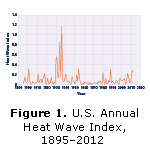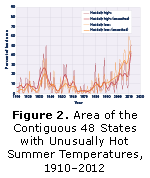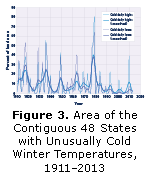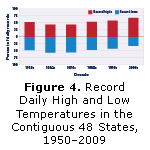Climate Change
Climate Change Indicators in the United States
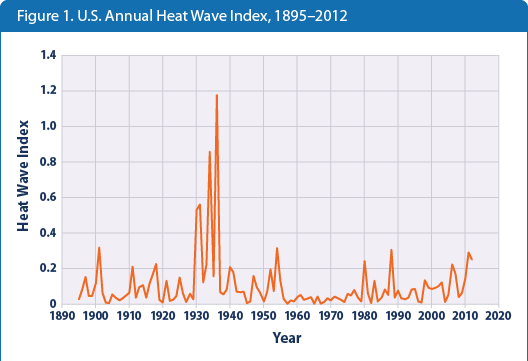
Data source: Kunkel, 2013 5

This graph shows the percentage of the land area of the contiguous 48 states with unusually hot daily high and low temperatures during the months of June, July, and August. The thin lines represent individual years, while the thick lines show a nine-year weighted average. Red lines represent daily highs, while orange lines represent daily lows. The term "unusual" is based on the long-term average conditions at each location.
Data source: NOAA, 2012 6
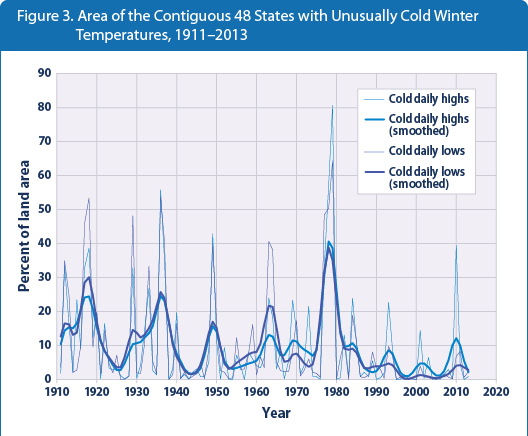
Data source: NOAA, 2013 7
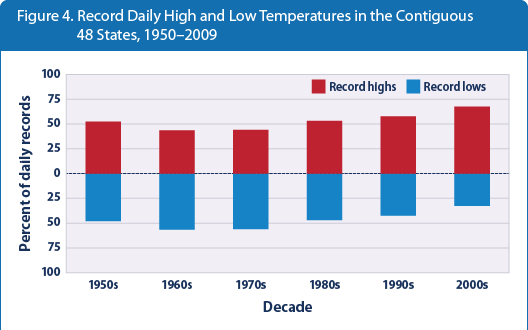
This figure shows the percentage of daily temperature records set at weather stations across the contiguous 48 states by decade. Record highs (red) are compared with record lows (blue).
Data source: Meehl et al., 2009 8
Key Points
- Heat waves were frequent and widespread in the 1930s, and these remain the most severe heat waves in the U.S. historical record (see Figure 1). Poor land use practices and many years of intense drought (the "Dust Bowl") contributed to these heat waves by depleting soil moisture and reducing the moderating effects of evaporation. 4
- Unusually hot summer days (highs) have become more common over the last few decades (see Figure 2). The occurrence of unusually hot summer nights (lows) has increased at an even faster rate. This trend indicates less "cooling off" at night.
- The 20th century saw many winters with widespread patterns of unusually low temperatures, including a particularly large spike in the late 1970s (see Figure 3). Since the 1980s, though, unusually cold winter temperatures have become less common—particularly very cold nights (lows).
- If the climate were completely stable, one might expect to see highs and lows each accounting for about 50 percent of the records set. However, since the 1970s, record-setting daily high temperatures have become more common than record lows across the United States (see Figure 4). The most recent decade had twice as many record highs as record lows.
Background
Unusually hot or cold temperatures can result in prolonged extreme weather events like summer heat waves or winter cold spells. Heat waves can lead to illness and death, particularly among older adults, the very young, and other vulnerable groups (see the Heat-Related Deaths indicator). People can also die from exposure to extreme cold (hypothermia). In addition, prolonged exposure to excessive heat and cold can damage crops and injure or kill livestock. Extreme heat can lead to power outages as heavy demands for air conditioning strain the power grid, while extremely cold weather increases the need for heating fuel.
Record-setting daily temperatures, heat waves, and cold spells are a natural part of day-to-day variation in weather. However, as the Earth's climate warms overall, heat waves are expected to become more frequent, longer, and more intense. 1,2 Higher heat index values (which combine temperature and humidity to describe perceived temperature) are expected to increase discomfort and could aggravate health issues. Conversely, cold spells are expected to decrease. In most locations, scientists expect daily minimum temperatures throughout the year to become warmer at a faster rate than daily maximum temperatures. 3
About the Indicator
Trends in extreme temperatures can be examined in a variety of ways. This indicator covers several approaches by looking at prolonged heat wave events as well as unusually hot or cold daily highs and lows. The data come from thousands of weather stations across the United States. National patterns can be determined by dividing the country into a grid and examining the data for one station in each cell of the grid. This method ensures that the results are not biased toward regions that happen to have many stations close together.
Figure 1 shows the U.S. Annual Heat Wave Index, which tracks the occurrence of heat wave conditions across the contiguous 48 states from 1895 to 2012. While there is no universal definition of a heat wave, this index defines a heat wave as a four-day period with an average temperature that would only be expected to occur once every 10 years, based on the historical record. The index value for a given year depends on how often heat waves occur and how widespread they are. For example, an index value of 0.2 could mean that 20 percent of the country experienced one heat wave, 10 percent of the country experienced two heat waves, or some other combination of frequency and area resulted in this value.
Figures 2 and 3 show trends in the percentage of the country's area experiencing unusually hot temperatures in the summer and unusually cold temperatures in the winter. These graphs are based on daily maximum temperatures, which usually occur during the day, and daily minimum temperatures, which usually occur at night. At each station, the recorded highs and lows are compared with the full set of historical records. After averaging over a particular month or season of interest, the coldest 10 percent of years are considered "unusually cold" and the warmest 10 percent are "unusually hot." For example, if last year's summer highs were the 10th warmest on record for a particular location with more than 100 years of data, that year's summer highs would be considered unusually warm. Data are available from 1910 to 2012 for summer (June through August) and from 1911 to 2013 for winter (December of the previous year through February).
Many people are familiar with record daily high and low temperatures, which are frequently mentioned in weather reports. Figure 4 looks at trends in these records by comparing the number of record-setting highs with the number of record-setting lows by decade. These data come from a set of weather stations that have collected data consistently from 1950 through 2009.
Indicator Notes
Temperature data are less certain for the early part of the 20th century because fewer stations were operating at that time. In addition, measuring devices and methods have changed over time, and some stations have moved. The data have been adjusted to the extent possible to account for some of these influences and biases, however, and these uncertainties are not sufficient to change the fundamental trends shown in the figures.
Data Sources
The data for this indicator are based on measurements from weather stations managed by the National Oceanic and Atmospheric Administration. Figure 1 uses data from the National Weather Service Cooperative Observer Network; these data are available online at: www.nws.noaa.gov/os/coop
/what-is-coop.html. Figures 2 and 3 are based on the U.S. Climate Extremes Index; for data and a description of the index, see: www.ncdc.noaa.gov/
extremes/cei. Figure 4 uses National Weather Service data processed by Meehl et al. (2009).
9
Technical Documentation
- Download related technical information PDF (9 pp, 360K, About PDF)



